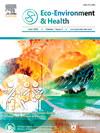Beyond the tailpipe: Review of non-exhaust airborne nanoparticles from road vehicles
引用次数: 0
Abstract
With the electrification of road vehicles leading to a reduction in tailpipe emissions, the relative contribution of non-exhaust emissions (NEEs) has become increasingly prominent. NEEs, particularly nanoparticles smaller than 100 nm in aerodynamic diameter (PM0.1), present significant health and environmental risks. A comprehensive understanding and strategic management of these emissions are urgently required to mitigate their impact. This article reviews existing studies and reveals that nanoparticles in NEEs are generated from brake and tyre wear under critical temperature conditions, while road wear and resuspension do not directly produce nanoparticles but contribute to larger particles. Common methodologies in studying these emissions include laboratory experiments (with brake dynamometers, tyre dynamometers, chassis dynamometers, and simulators), field tests (tunnel and real road emission tests), and source apportionments. The emission rate of PM0.1, calculated based on particle number concentration, ranges from 1.2% to 98.9%, depending on driving conditions. Extreme driving conditions result in high nanoparticle generation. Emission inventories reveal that PM0.1 emission levels have remained stable since 2020, without an observable reduction. Moreover, emissions attributable to brake wear are found to surpass those from tyre wear. Current mitigation strategies focus on material improvements for brake pads and tyres, better road maintenance, and regulatory measures. Mitigating the environmental and health impacts of nanoscale particulate matter requires additional research and regulations to control it at the source.

超越排气管:道路车辆非排气空气中的纳米颗粒综述
随着道路车辆的电气化导致尾气排放的减少,非废气排放(NEEs)的相对贡献日益突出。新能源电子产品,特别是空气动力学直径小于100纳米的纳米颗粒(PM0.1),具有重大的健康和环境风险。迫切需要对这些排放进行全面的了解和战略管理,以减轻其影响。本文回顾了现有的研究,揭示了NEEs中的纳米颗粒是在临界温度条件下由刹车和轮胎磨损产生的,而道路磨损和再悬浮并不直接产生纳米颗粒,而是促成了更大的颗粒。研究这些排放的常用方法包括实验室实验(使用制动测功机、轮胎测功机、底盘测功机和模拟器)、现场测试(隧道和实际道路排放测试)和源分摊。根据不同的驾驶条件,基于颗粒物数浓度计算的PM0.1的排放率在1.2%到98.9%之间。极端的驾驶条件导致高纳米颗粒的产生。排放清单显示,自2020年以来,PM0.1的排放水平保持稳定,没有明显的减少。此外,由于刹车磨损造成的排放超过了轮胎磨损造成的排放。目前的缓解战略侧重于改进刹车片和轮胎的材料、改善道路维护和监管措施。减轻纳米级颗粒物质对环境和健康的影响需要更多的研究和法规,以便从源头上控制它。
本文章由计算机程序翻译,如有差异,请以英文原文为准。
求助全文
约1分钟内获得全文
求助全文
来源期刊

Eco-Environment & Health
环境科学与生态学-生态、环境与健康
CiteScore
11.00
自引率
0.00%
发文量
18
审稿时长
22 days
期刊介绍:
Eco-Environment & Health (EEH) is an international and multidisciplinary peer-reviewed journal designed for publications on the frontiers of the ecology, environment and health as well as their related disciplines. EEH focuses on the concept of “One Health” to promote green and sustainable development, dealing with the interactions among ecology, environment and health, and the underlying mechanisms and interventions. Our mission is to be one of the most important flagship journals in the field of environmental health.
Scopes
EEH covers a variety of research areas, including but not limited to ecology and biodiversity conservation, environmental behaviors and bioprocesses of emerging contaminants, human exposure and health effects, and evaluation, management and regulation of environmental risks. The key topics of EEH include:
1) Ecology and Biodiversity Conservation
Biodiversity
Ecological restoration
Ecological safety
Protected area
2) Environmental and Biological Fate of Emerging Contaminants
Environmental behaviors
Environmental processes
Environmental microbiology
3) Human Exposure and Health Effects
Environmental toxicology
Environmental epidemiology
Environmental health risk
Food safety
4) Evaluation, Management and Regulation of Environmental Risks
Chemical safety
Environmental policy
Health policy
Health economics
Environmental remediation
 求助内容:
求助内容: 应助结果提醒方式:
应助结果提醒方式:


